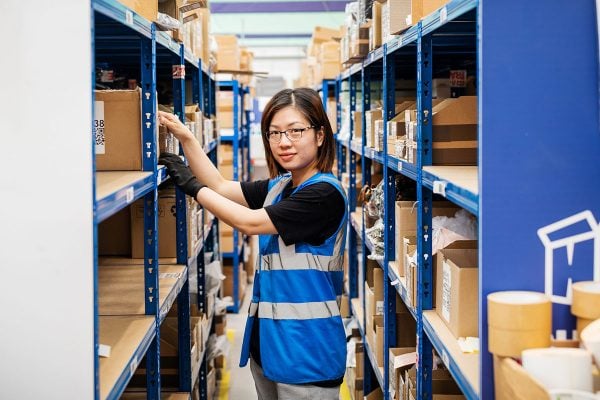UK shoppers are returning £7 billion of purchases every year, leading to a ‘phantom economy’ of lost revenue for retailers, with sales coming in that they ultimately can’t recognise.
New research from Barclaycard, which processes nearly half of the nation’s credit and debit card transactions, reveals that a quarter of retailers (26%) have seen a rise in returns in-store and online over the last two years, with the number of returned items up by 22% on average.
These figures are even higher among fashion, footwear and accessory retailers as consumers increasingly change their minds after making a purchase, with almost four in ten (37%) of these businesses reporting that refunds have risen since 2016 .
Inconsistent sizing driving ‘serial returners’ culture
Clothes shopping online is fuelling the rise of the ‘serial returner’, as almost half of the amount consumers spend ends up being refunded by retailers. While Brits splash out on average £313 on online clothes shopping each year, they actually end up sending back £146-worth of this (47%). In fact, a third (33%) of shoppers buy clothes online expecting that items will be unsuitable before they’ve even tried them on.
The number one reason given by shoppers for returning clothes is the variation in measurement which determines sizing in the UK – a current hot topic in the fashion retail industry. Two in five consumers (40%) say they return clothing bought online because items don’t fit as they expect them to.
To combat the issue of inconsistent sizing across different brands, one in 10 (nine%) shoppers have taken to buying multiple sizes of the same item and returning those that don’t fit – a trend 27% of retailers say they have identified.
In order to minimise returns, 36% of shoppers are calling for brands to improve online size guidelines – with 35% seeking the standardisation of sizing across retailers. A further 16% would also like to see wider use of technology online, such as augmented reality, to help them visualise how products will look when worn.
“While frustrating, returns are a vital indicator of product performance and customer satisfaction. Sure, rising return rates are a challenge for brands and retailers, but an easy returns process needn’t be the undoing of a marketplace. The biggest reason for returning items was that they didn’t fit, with 40 per cent blaming inconsistent sizing by various clothes manufacturers. The secret to lowering returns is being proactive and putting the customer first. It is always important to engage with consumers and start a dialogue, whether public or private, even if the conversation may start off negatively. Candid customer insights help inform other consumers making their purchase decisions. Simply adding a sentence such as ‘customers who have purchased this product advise that this item comes up small, try ordering a size up’, can mitigate the risk of further returns. Improving the online accuracy of products with visual content also reduces ‘string-purchases’ where the same or a similar product is bought in different sizes and the ones that don’t fit are returned.”
– Sophie Light-Wilkinson, VP Marketing, EMEA, Bazaarvoice
Retailer coping strategies
Returning purchases is now simpler than ever: over half of Brits (52%) think that retailers have made the returns process more convenient, while three in 10 (29%) merchants say this is a direct cause of the rising serial returners trend. In fact, just over half (54%) of retailers think that customers’ decisions about where to shop are now influenced by the vendor’s returns policy.
At the same time, merchants are looking at a variety of ways to tackle the growing volume of returns. The top 10 methods retailers have introduced to help combat the rise in returns are:
| Action | Percentage of retailers who’ve taken this step |
| Provided more information about products online, e.g. exact measurements | 52% |
| Made the returns policy more transparent e.g. making it more prominent on a website | 48% |
| Increased the price of items to cover the cost of managing and processing returns | 29% |
| Worked with a logistics provider to speed up the returns process | 28% |
| Introduced a new system to handle returned stock that can’t be re-sold | 26% |
| Ensured ‘quality purchases’ by limiting the options available to customers based on preferences | 25% |
| Reduced the time customers have to return items to get a clearer picture of stock inventory | 23% |
| Lengthened their returns policy | 23% |
| Hired more employees to process and manage returns | 20% |
| Introduced a ‘try before you buy’ service – allowing customers to only pay for items they decide to keep | 18% |
The cost of free returns to retailers
In addition to the potential revenue lost through the ‘phantom economy’, the majority of online retailers (55%) also offer free returns which can come at a cost to their bottom line. Given that nearly seven in ten (69%) consumers expect free returns ‘as standard’, it’s increasingly important for retailers to offer solutions that reduce the volume of returns they receive.
“It’s clear having an effective and convenient returns policy that satisfies customer needs is a crucial factor of success for retailers. While many have adopted new processes to help manage increasing returns volumes, the real focus should be on measures which help to reduce over-ordering in the first place.Implementing technology such as virtual fitting rooms which allow shoppers to visualise how products will look when worn, for example, is one way retailers could reduce the number of returns and refunds they contend with, and in turn, the size of the ‘phantom economy’.”
– Konrad Kelling, Managing Director of Customer Solutions, Barclaycard
Perhaps counter-intuitively, however, many retailers see offering free returns as key to their customer experience, with two in five (41%) considering free returns as one of their business’ strongest selling points. A further 37% say providing free returns has led to increased customer satisfaction and 44% feel they need to offer this service to keep up with the competition.
“As a nation of clothes lovers, we’ve become accustomed to over-ordering and subsequently returning on mass clothes bought online. Today’s busy shopper often buys on the move and in a rush and it can be easy to forget that packaging up and returning items that aren’t right can be a time-consuming task.It may sound simple but my advice is to try and shop online in the same way as you would in-store and only buy clothes that you really want and ultimately, will wear. Rather than buying on impulse you should ask yourself if the purchase is really going to work in your wardrobe. Small steps like making ‘wish lists’, reviewing items more critically and avoiding styles you haven’t tried and tested before can help prevent the hassle of returning later.”
– Naomi Isted, Stylist, TV Presenter
Image: Fotolia







